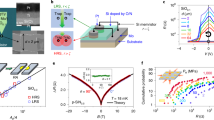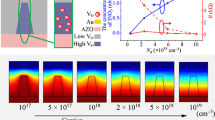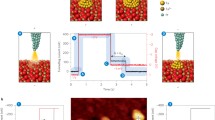Abstract
The memristor, a two-terminal memory device with units of resistance, has continued to gain momentum as simpler and more versatile memristive devices are discovered. Amorphous metal-oxide devices have emerged as potential replacements for organic and silicon materials in thin-film electronics. This work presents memristive devices based on amorphous TiOx which were synthesized using a simplified sol-gel process that does not require a dry nitrogen flow step to fabricate amorphous films of titanium oxide (TiOx) for memristive devices. This simplified process significantly decreases the cost and complexity of the fabrication of memristive devices. The memristive behavior was characterized by I-V curves and read-write sequential pulses. We report on the effects of different TiOx layers on I-V curve behavior, stability, aging of the devices as well as the influence of interfaces and electrode materials in the memristive properties. Devices made as a stack of copper electrode, different TiOx layers and aluminum electrode showed best results for on/off ratio than other devices in this work, as well better stability of resistive switching properties.








Similar content being viewed by others
References
L.O. Chua, S.M. Kang, Memristive devices and systems. Proc. IEEE 64, 209–223 (1976). https://doi.org/10.1109/PROC.1976.10092
L. Chua, Resistance switching memories are memristors. Appl. Phys. A Mater. Sci. Process. 102, 765–783 (2011). https://doi.org/10.1007/s00339-011-6264-9
E. Gale, TiO2 -based memristors and ReRAM: Materials, mechanisms and models (a review). Semicond. Sci. Technol. 29, 104004 (2014). https://doi.org/10.1088/0268-1242/29/10/104004
S.G. Hu, S.Y. Wu, W.W. Jia, et al., Review of nanostructured resistive switching Memristor and its applications. Nanosci. Nanotechnol. Lett. 6, 729–757 (2014). https://doi.org/10.1166/nnl.2014.1888
D.B. Strukov, G.S. Snider, D.R. Stewart, R.S. Williams, The missing memristor found. Nature 453(7191), 80–83 (2008). https://doi.org/10.1038/nature06932
H. Nili, S. Walia, S. Balendhran, et al., Nanoscale resistive switching in amorphous Perovskite oxide (a-SrTiO3) Memristors. Adv. Funct. Mater. 24, 6741–6750 (2014). https://doi.org/10.1002/adfm.201401278
F. Argall, Switching phenomena in titanium oxide thin films. Solid State Electron. 11, 535–541 (1968). https://doi.org/10.1016/0038-1101(68)90092-0
J.Y. Kim, S.H. Kim, H.-H. Lee, et al., New architecture for high-efficiency polymer photovoltaic cells using solution-based titanium oxide as an optical spacer. Adv. Mater. 18, 572–576 (2006). https://doi.org/10.1002/adma.200501825
N. Gergel-Hackett, B. Hamadani, B. Dunlap, et al., A flexible solution-processed Memristor. IEEE Electron Device Lett. 30, 706–708 (2009). https://doi.org/10.1109/LED.2009.2021418
X. Tang, Crack-free TiO2 thin films with selfassembling nano-particles fabricated through in-situ sol–gel processing in reverse micelles. Surf. Coat. Technol. 221, 37–43 (2013). https://doi.org/10.1016/j.surfcoat.2013.01.025
Ü.Ö.A. Arıer, F.Z. Tepehan, Influence of heat treatment on the particle size of nanobrookite TiO2 thin films produced by sol–gel method. Surf. Coat. Technol. 206, 37–42 (2011). https://doi.org/10.1016/j.surfcoat.2011.06.039
L. Ge, M.X. Xu, M. Sun, Synthesis and characterization of TiO2 photocatalytic thin films prepared from refluxed PTA sols. Mater. Lett. 60, 287–290 (2006). https://doi.org/10.1016/j.matlet.2005.08.036
D. Chen, E.H. Jordan, M. Gell, M. Wei, Apatite formation on alkaline-treated dense TiO2 coatings deposited using the solution precursor plasma spray process. Acta Biomater. 4, 553–559 (2008). https://doi.org/10.1016/j.actbio.2007.11.008
M.A. Mamun, A.H. Chowdhury, K. Chen, et al., Rapid and low-temperature processing of Mesoporous and Nanocrystalline TiO2 film using microwave irradiation. ACS Appl. Energy Mater. 1, 6288–6294 (2018). https://doi.org/10.1021/acsaem.8b01287
Y.-H. Kim, J.-S. Heo, T.-H. Kim, S. Park, M.H. Yoon, J. Kim, M.S. Oh, G.R. Yi, Y.Y. Noh, S.K. Park, Flexible metal-oxide devices made by room-temperature photochemical activation of sol–gel films. Nature 489(7414), 128–132 (2012). https://doi.org/10.1038/nature11434
E. Gale, R. Mayne, A. Adamatzky, B.D. Costello, Drop-coated titanium dioxide memristors. Mater. Chem. Phys. 143, 524–529 (2014). https://doi.org/10.1016/j.matchemphys.2013.09.013
H. Abunahla, M.A. Jaoude, C.J. O’Kelly, B. Mohammad, Sol-gel/drop-coated micro-thick TiO2 memristors for γ-ray sensing. Mater. Chem. Phys. 184, 72–81 (2016). https://doi.org/10.1016/j.matchemphys.2016.09.027
S.K. Tripathi, R. Kaur, H. Kaur, et al., Fabrication and electrical characterization of memristor with TiO2 as an active layer. AIP Conf. Proc. 1661, 110027 (2015). https://doi.org/10.1063/1.4915472
J.H. Park, D.S. Jeon, T.G. Kim, Improved uniformity in the switching characteristics of ZnO-based memristors using Ti sub-oxide layers. J. Phys. D. Appl. Phys. 50, 015104 (2016). https://doi.org/10.1088/1361-6463/50/1/015104
K.M. Kim, J.M. Zhang, C. Graves, J.J. Yang, B.J. Choi, C.S. Hwang, Z. Li, R.S. Williams, Low-power, self-rectifying, and forming-free Memristor with an asymmetric programing voltage for a high-density crossbar application. Nano Lett. 16(11), 6724–6732 (2016). https://doi.org/10.1021/acs.nanolett.6b01781
M. Cernea, O. Monnereau, P. Llewellyn, et al., Sol–gel synthesis and characterization of Ce doped-BaTiO3. J. Eur. Ceram. Soc. 26, 3241–3246 (2006). https://doi.org/10.1016/j.jeurceramsoc.2005.09.039
R. Waser, R. Dittmann, G. Staikov, K. Szot, Redox-based resistive switching memories – Nanoionic mechanisms, prospects, and challenges. Adv. Mater. 21, 2632–2663 (2009). https://doi.org/10.1002/adma.200900375
I. Abraham, An advection-diffusion model for the vacancy migration Memristor. IEEE Access 4, 7747–7757 (2016). https://doi.org/10.1109/access.2016.2621721
L. Alekseeva, T. Nabatame, T. Chikyow, A. Petrov, Resistive switching characteristics in memristors with Al2O3/TiO2 and TiO2/Al2O3 bilayers. Jpn. J. Appl. Phys. 55, 08PB02 (2016). https://doi.org/10.7567/JJAP.55.08PB02
J. Lappalainen, J. Mizsei, M. Huotari, Neuromorphic thermal-electric circuits based on phase-change VO2 thin-film memristor elements. J. Appl. Phys. 125, 044501 (2019). https://doi.org/10.1063/1.5037990
N. S. M. Hadis, A. A. Manaf, S. H. Herman and S. H. Ngalim, High Roff/Ron ratio liquid based memristor sensor using sol gel spin coating technique, 2015 IEEE SENSORS, Busan, 2015, pp. 1–4. https://doi.org/10.1109/ICSENS.2015.7370379
M.D. Pickett, D.B. Strukov, J.L. Borghetti, et al., Switching dynamics in titanium dioxide memristive devices. J. Appl. Phys. 106, 74508 (2009). https://doi.org/10.1063/1.3236506
M. Cölle, M. Büchel, D.M. de Leeuw, Switching and filamentary conduction in non-volatile organic memories. Org. Electron. 7, 305–312 (2006). https://doi.org/10.1016/j.orgel.2006.03.014
F. Pan, C. Chen, Z. Wang, et al., Nonvolatile resistive switching memories-characteristics, mechanisms and challenges. Pro. Nat. Sci. Mater. Int. 20, 1–15 (2010). https://doi.org/10.1016/S1002-0071(12)60001-X
L. Yang, C. Kuegeler, K. Szot, et al., The influence of copper top electrodes on the resistive switching effect in TiO2 thin films studied by conductive atomic force microscopy. Appl. Phys. Lett. 95, 013109 (2009). https://doi.org/10.1063/1.3167810
H.Y. Jeong, J.Y. Lee, S.-Y. Choi, J.W. Kim, Microscopic origin of bipolar resistive switching of nanoscale titanium oxide thin films. Appl. Phys. Lett. 95, 162108 (2009). https://doi.org/10.1063/1.3251784
X.-J. Zhu, J. Shang, R.-W. Li, Resistive switching effects in oxide sandwiched structures. Front. Mater. Sci. 6(3), 183–206 (2012). https://doi.org/10.1007/s11706-012-0170-8
T.D. Dongale, K.V. Khot, S.S. Mali, et al., Development of Ag/ZnO/FTO thin film memristor using aqueous chemical route. Mater. Sci. Semicond. Process. 40, 523–526 (2015). https://doi.org/10.1016/j.mssp.2015.07.004
Y. Khrapovitskaya, N. Maslova, I. Sokolov, et al., The titanium oxide memristor contact material’s influence on element’s cyclic stability to degradation. Phys. Status Solidi C 12, 202–205 (2015). https://doi.org/10.1002/pssc.201400109
B. Mohammad, M.A. Jaoude, V. Kumar, et al., State of the art of metal oxide memristor devices. Nanotechnol. Rev. 5, 311–329 (2016). https://doi.org/10.1515/ntrev-2015-0029
B.P.S. Rathore, R. Prakash, D. Kaur, Effect of AlN layer on the resistive switching properties of TiO2 based ReRAM memory devices. Curr. Appl. Phys. 18, 102–106 (2018). https://doi.org/10.1016/j.cap.2017.10.005
Y.H. Do, J.S. Kwak, J.P. Hong, et al., Al electrode dependent transition to bipolar resistive switching characteristics in pure TiO2 films. J. Appl. Phys. 104, 114512 (2008). https://doi.org/10.1063/1.3032896
Y.C. Bae, A.R. Lee, J.S. Kwak, et al., Dependence of resistive switching behaviors on oxygen content of the Pt/TiO2−x/Pt matrix. Curr. Appl. Phys. 11, e66–e69 (2011). https://doi.org/10.1016/j.cap.2010.11.125
Z. Yan, Y. Guo, G. Zhang, J.-M. Liu, High-performance programmable memory devices based on co-doped BaTiO3. Adv. Mater. 23(11), 1351–1355 (2011). https://doi.org/10.1002/adma.201004306
Acknowledgements
Dr. Everaldo N. Moreira was supported by Sao Paulo Research Foundation (FAPESP) (proc. 2015/07316-9). This work was partially supported by the US National Science Foundation (NSF ENG ECCS 1709641).
Author information
Authors and Affiliations
Corresponding author
Additional information
Publisher’s note
Springer Nature remains neutral with regard to jurisdictional claims in published maps and institutional affiliations.
Rights and permissions
About this article
Cite this article
Nassar Moreira, E., Kendall, J., Maruyama, H. et al. Simplified sol-gel processing method for amorphous TiOx Memristors. J Electroceram 44, 52–58 (2020). https://doi.org/10.1007/s10832-019-00198-z
Received:
Accepted:
Published:
Issue Date:
DOI: https://doi.org/10.1007/s10832-019-00198-z




